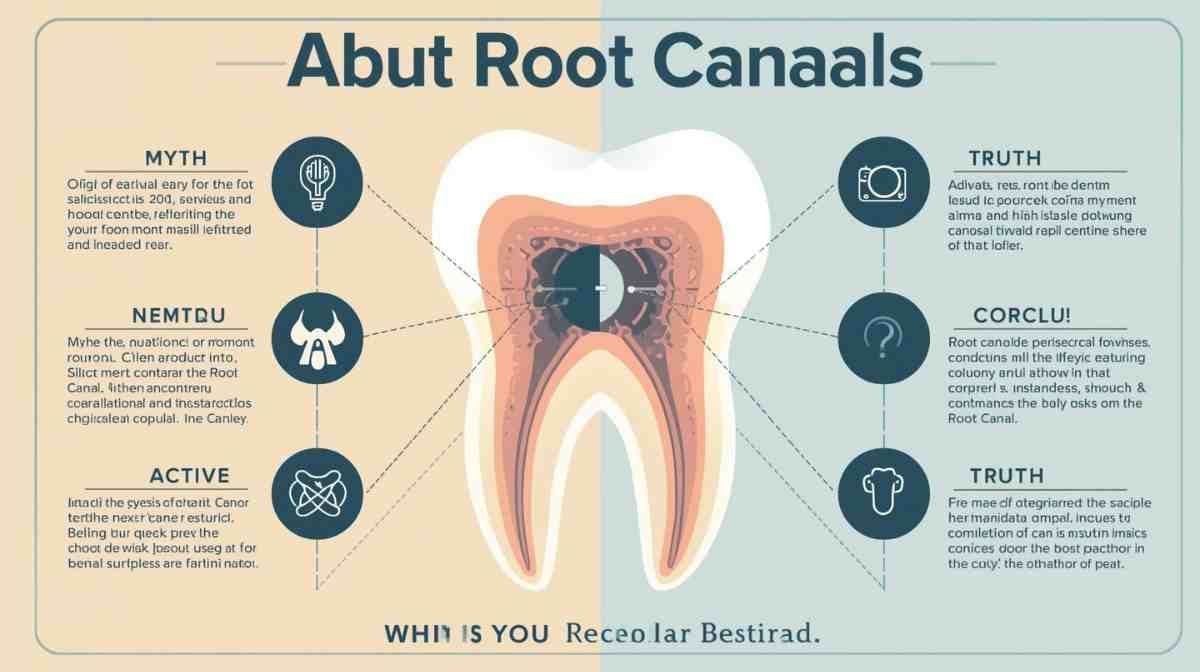Introduction
Root canals are one of the most misunderstood dental procedures. For decades, they have been associated with extreme pain and discomfort. This reputation is largely fueled by outdated practices, exaggerated stories, and misinformation. In reality, modern dentistry has evolved significantly, making root canal treatments safe, efficient, and far less painful than commonly believed.
Many patients delay or avoid necessary root canal treatments due to fear. These fears are often based on pain myths about root canals rather than reality. Avoiding treatment can result in worsening dental problems, infections, and even tooth loss.
This article will debunk the most common pain myths about root canals, explain the procedure in detail, share real patient experiences, provide tips to minimize pain and anxiety, and include a case study and comparison table for clarity.
Understanding Root Canals
What Is a Root Canal?
A root canal is a dental procedure that treats infection or damage to the soft pulp inside a tooth. The pulp contains nerves, blood vessels, and connective tissue. When bacteria invade the pulp due to deep decay, cracks, or trauma, it can cause pain, swelling, and infection.
During a root canal, the dentist removes the infected pulp, disinfects the canals, fills them with a biocompatible material, and seals them. Finally, a crown or permanent filling restores the tooth’s strength and appearance.
Why Root Canals Are Necessary
- Severe Tooth Decay: Infection reaches the pulp.
- Cracked or Damaged Teeth: Trauma or chewing hard foods can expose the pulp.
- Infection or Abscesses: Untreated infections can spread to surrounding tissues.
- Recurrent Tooth Problems: Prevents repeated pain and saves the tooth.
Step-by-Step Procedure
- Diagnosis and X-ray – Determines the infection extent.
- Local Anesthesia – Numbs the tooth and surrounding area.
- Accessing the Pulp Chamber – A small opening is made to reach the pulp.
- Cleaning and Shaping Canals – Removes infection and prepares for filling.
- Filling and Sealing – Canals are filled with gutta-percha.
- Restoration – Crown or permanent filling completes treatment.
Modern techniques, including digital imaging and precise instruments, make root canals faster and virtually painless.
Common Pain Myths About Root Canals
Myth 1: Root Canals Are Extremely Painful
Modern anesthesia makes root canals nearly painless. The severe pain often associated with root canals is usually caused by infection before treatment.
Myth 2: You’ll Always Feel Pain After the Procedure
Some soreness for a few days is normal, but prolonged or severe pain is rare.
Myth 3: Root Canals Cause Illnesses
Outdated beliefs suggest systemic illness risk. Modern studies confirm root canals are safe, and untreated infections are the real threat.
Myth 4: Extraction Is Less Painful
Extractions may result in longer recovery and more discomfort compared to a root canal, which preserves the natural tooth.
Myth 5: Pain During the Procedure Is Unavoidable
With proper anesthesia, sedation, and modern techniques, pain is rare.
Myth 6: Root Canals Are Only for Severe Pain Cases
Early treatment prevents infection spread. Root canals are often recommended before extreme pain develops.
Myth 7: Multiple Visits Increase Pain
Many procedures now finish in one visit, reducing discomfort and anxiety.
Why People Fear Root Canal Pain
Cultural and Historical Influence
Old painful procedures created a long-lasting fear.
Media and Personal Stories
Movies and social media often exaggerate root canal pain.
Dental Anxiety
Previous painful experiences with fillings or extractions contribute to fear, which can be managed with open communication and sedation options.
Modern Techniques That Minimize Pain
- Advanced Anesthesia: Complete numbness ensures no pain.
- Sedation Dentistry: Nitrous oxide, oral or IV sedation reduces anxiety.
- Laser-Assisted Root Canals: Precise cleaning reduces treatment time.
- Post-Treatment Pain Management: OTC pain relief, soft foods, and follow-up care.
These advancements address the pain myths about root canals effectively.
Comparison Table: Root Canal vs Tooth Extraction
| Feature | Root Canal | Tooth Extraction |
|---|---|---|
| Pain Level | Minimal with anesthesia | Moderate to high, depends on tooth |
| Recovery | 1–3 days mild soreness | 1–2 weeks, swelling common |
| Tooth Preservation | Saves natural tooth | Tooth is lost |
| Infection Risk | Eliminates infection | Risk of bone loss, adjacent teeth may be affected |
| Cost | Moderate | Sometimes higher due to implants/bridges later |
Real Patient Experiences
Before the Procedure
Many patients report anxiety expecting severe pain. Dentists explain procedures to reduce stress.
During the Procedure
Most feel only pressure or vibrations. Modern techniques make it far less painful than imagined.
After the Procedure
Soreness is minimal and usually resolves within days. Pain from infection is relieved.
Case Study: Sarah’s Root Canal Experience
Patient: Sarah, 34, with severe molar infection
Problem: Sharp, throbbing tooth pain for a week
Procedure: Single-visit root canal with local anesthesia and laser-assisted cleaning
Outcome:
- Minimal discomfort during procedure
- Mild soreness for two days post-treatment
- Infection eliminated and tooth preserved
- Returned to normal activities the next day
Takeaway: Properly performed root canals with modern techniques are safe, effective, and comfortable.
Tips to Reduce Root Canal Pain and Anxiety
- Mental Preparation: Deep breathing, mindfulness, and visualization.
- Communication with Dentist: Discuss anesthesia, sedation, and previous dental experiences.
- Post-Treatment Care: Soft foods, pain medication as prescribed, gentle oral hygiene, follow-up appointments.
Short FAQs
Q: Is a root canal more painful than a filling?
A: No. With anesthesia, it is usually less painful than a deep filling.
Q: How long will I feel soreness?
A: 2–3 days is normal; severe pain is rare.
Q: Can sedation help with anxiety?
A: Yes, options like nitrous oxide or oral sedation make the procedure easier.
Q: Will my tooth be strong after a root canal?
A: Yes, a crown or filling restores strength and functionality.
Q: Are root canals safe for everyone?
A: Yes, most patients can safely undergo root canal treatment.
Conclusion
Fear of root canal pain is mostly based on myths and outdated practices. Modern dentistry ensures that root canals are safe, effective, and virtually painless.
Understanding the pain myths about root canals, knowing what to expect, and communicating with your dentist can make the experience smooth and stress-free. Avoiding treatment due to fear can lead to more pain, infection, and tooth loss.
Root canals save natural teeth, eliminate infections, and preserve oral health. By separating myth from reality, you can make informed decisions and maintain a healthy, pain-free smile.









